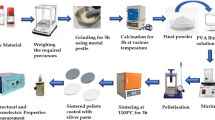Abstract
The determination of boron and phosphorus ionization energies in compensated silicon is very important for assessing the ionization level of dopants and their interaction with each other. In this paper, we achieved the boron and phosphorus ionization energies in compensated silicon by temperature-dependent luminescence for the first time. The results show that the boron and phosphorus ionization energies in heavily-compensated silicon have the same values as those in non-compensated silicon. This strongly suggests that both boron and phosphorus impurities with a concentration of ≤ 10 17 cm −3 should act as isolated acceptors and donors, but do not form complexes in silicon.
Similar content being viewed by others
References
Delannoy Y, Alemany C, Li K I, Proulx P, Trassy C (2002) Plasma-refining process to provide solar-grade silicon. Sol Energy Mater Sol Cells 72: 69–75
Pires J C S, Otubo J, Braga A F B, Mei P R (2005) The purification of metallurgical grade silicon by electron beam melting. J Mater Process Technol 169: 16–20
Martinuzzi S, Perichaud I, Trassy C, Degoulange J (2009) N-type multicrystalline silicon wafers prepared from plasma torch refined upgraded metallurgical feedstock. Prog Photovolt Res Appl 17: 297–305
Morito H, Karahashi T, Uchikoshi M, Isshiki M, Yamane H (2012) Low-temperature purification of silicon by dissolution and solution growth in sodium solvent. Silicon 4: 121–125
Wu J J, Ma W H, Yang B, Liu D C, Dai Y N (2012) Calculation and characterization of silicon-boron phases in metallurgical grade silicon. Silicon 4: 289–295
Wu J J, Li Y L, Ma W H, Liu K, Wei K X, Xie K Q, Yang B, Dai YN (2013) Impurities removal from metallurgical grade silicon using gas blowing refining techniques. Silicon. http://dx.doi.org/10.1007/s12633-013-9158-y.
Schutz-Kuchly T, Sanzone V, Veschetti Y (2013) N-type solar-grade silicon purified via the metallurgical route: characterisation and fabrication of solar cells. Prog Photovolt Res Appl 21: 1214–1221
Xiao C Q, Yang D R, Yu X G, Wang P, Chen P, Que D L (2012) Effect of dopant compensation on the performance of Czochralski silicon solar cells. Sol Energy Mater Sol Cells 101: 102–106
Tanay F, Dubois S, Enjalbert N, Veirman J (2011) Low temperature-coefficient for solar cells processed from solar-grade silicon purified by metallurgical route. Prog Photovolt Res Appl 19: 966–972
Soøiland A, Odden JO, Sandberg B, Friestad K, Håkedal J, Enebakk E, Braathen S (2012) Solar silicon from a metallurgical route by Elkem Solar – a viable alternative to virgin polysilicon. In: Proceedings of the 6th international workshop on crystalline silicon solar cells. Aix-les-bains, France
Flamant G, Kurtcuoglu V, Murray J, Steinfeld A (2006) Purification of metallurgical grade silicon by a solar process. Sol Energy Mater Sol Cells 90: 2099–2106
Braga A F B, Moreira S P, Zampieri P R, Bacchin J M G, Mei P R (2007) New processes for the production of solar-grade polycrystalline silicon: a review. Sol Energy Mater Sol Cells 92: 418–424
Veirman J, Dubois S, Enjalbert N, Garandet J P, Lemiti M (2011) Electrical properties of highly-doped and compensated solar-grade silicon wafers and solar cells. J Appl Phys 109(103711)
Xiao C Q, Yang D R, Yu X G, Gu X, Que D L (2012) Influence of the compensation level on the performance of p-type crystalline silicon solar cells theoretical calculations and experimental study. Sol Energy Mater Sol Cells 107: 263–271
Forster M, Cuevas A, Fourmond E, Rougieux F E, Lemiti M (2012) Impact of incomplete ionization of dopants on the electrical properties of compensated p-type silicon. J Appl Phys 111: 043701
Altermatt P P, Schenk A, Heiser G (2006) A simulation model for the density of states and for incomplete ionization in crystalline silicon. I. Establishing the model in Si:P. J Appl Phys 100: 113714
Altermatt P P, Schenk A, Schmithusen B, Heiser G (2006) A simulation model for the density of states and for incomplete ionization in crystalline silicon. II. Investigation of Si:As and Si:B and usage in device simulation. J Appl Phys 100: 113715
Tajima M, Iwai T, Toyota H, Binetti S, Macdonald D (2010) Fine structure due to donor–acceptor pair luminescence in compensated Si. Appl Phys Express 3: 071301
Tajima M, Iwai T, Toyota H, Binetti S, Macdonald D (2011) Donor-acceptor pair luminescence in compensated Si for solar cells. J Appl Phys 110: 043506
Enck R C, Honig A (1969) Radiative Spectra from shallow donor-acceptor electron transfer in silicon. Phys Rev 177: 1182–1193
Xiang L L, Li D S, Jin L, Pivac B, Yang D R (2012) The origin of 0.78 eV line of the dislocation related luminescene in silicon. J Appl Phys 112: 063528
Sauer R, Weber J, Stolz J, Weber E R, Kusters K H, Alexander H (1985) Dislocation-related photoluminescence in silicon. Appl Phys A Mater Sci Process 36: 1–13
Modanese C, Acciarri M, Binetti S, Søiland A, Sabatino MD, Arnberg L (2012) Temperature-dependent Hall-effect measurements of p-type multicrystalline compensated solar grade silicon. Prog Photovolt Res Appl. http://dx.doi.org/10.1002/pip.2223.
Rezgui B D, Veirman J, Dubois S, Palais O (2012) Study of donor-acceptor pair luminescence in highly doped and compensated Cz silicon. Phys Status Solidi A 209: 1917–1920
Sze SM (1981) Physics of semicondutor devices, 2nd edn
Riklund R, Chao K A (1982) Concentration-fluctuation model of a doped semiconductor in the nonmetallic regime: Pseudocluster investigation. Phys Rev B 26: 2168–2180
Acknowledgments
This work is supported by National Natural Science Foundation of China (No. 61274057), National Key Technology R&D Program (2011BAE03B13), and Innovation Team Project of Zhejiang Province (2009R50005).
Author information
Authors and Affiliations
Corresponding author
Rights and permissions
About this article
Cite this article
Xiao, C., Yang, D., Yu, X. et al. Determination of the Boron and Phosphorus Ionization Energies in Compensated Silicon by Temperature-Dependent Luminescence. Silicon 9, 147–151 (2017). https://doi.org/10.1007/s12633-014-9193-3
Received:
Accepted:
Published:
Issue Date:
DOI: https://doi.org/10.1007/s12633-014-9193-3




